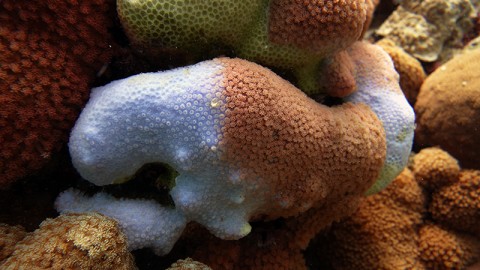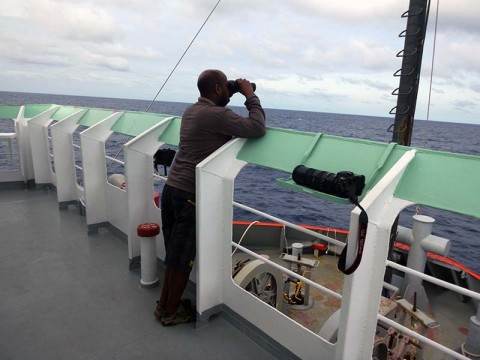BIOT Science Expedition 2014 - Exploring Fresh Territory
Exploring fresh territory BIOT Science Expedition Day 6
It is a rare thing these days to be able to explore a place that perhaps no one else has ever seen first hand. The reef we visited today is a place where, on entering the water on scuba, you may well be the first person to see that seabed ever before. In the early hours of the morning we cruised to a fully submerged atoll that reaches to within meters of the surface but never breaks it. It is sufficiently remote that people rarely visit, and even more rarely get beneath the surface.

One of our party dived here in 1979, and David, who has just joined us from the Bertarelli Foundation's research vessel, ventured underwater on this reef in the last few days whilst undertaking his shark research. Although I’ve been to the territory many times I have never had the opportunity to dive this reef and was very excited at the prospect. I was not disappointed. The corals were beautiful, receding into the distance in branched, mounded and encrusting growths with thousands upon thousands of varied fish flitting, shoaling and cruising overhead. A storm of colour pleasing the eye. Giants floated through, a turtle stopping to occasionally rest amongst the coral garden, Napoleon Wrasse regally parading overhead, nurse shark hurrying along and grey reef sharks eyeing everything keenly while cruising by.

In this distracting environment Courtney showed a lot of resolve to keep her head down (most of the time...) to survey the corals. I’ll let her elaborate a little on what was keeping her busy beneath the hive of life in these waters.

“The scope and magnitude of the global coral reef crisis is daunting for most, especially those of us who understand all too well how complex the threats can be. So how do we bring this seemingly unapproachable issue to a level at which local management action can be effective while still addressing the synergistic nature of global and local threats? While I will be the first to admit that I chose a slightly morbid career path, I’m fascinated with how disease shapes and reshapes coral reefs. Disease, much like other ecological processes, is a part of all wildlife populations and nature’s way of weeding out the weaker individuals. However, the steady increase in coral disease during the last 40 years, together with the daunting list of other stressors, have drastically reshaped the structure and function of reef ecosystems and are now considered one of the major contributors to global coral reef degradation. As a disease ecologist what’s especially concerning is that disease levels can be exacerbated by environmental stress. With atmospheric CO2 predicted to rise as high as 900 ppm by the end of the 21st century and predicted climate-induced increases in disease, it is crucial to understand how reefs will respond to climate change in the absence of other anthropogenic stressors (such as pollution). This is particularly challenging given the lack of ‘baseline’ data for most regions, but is possible to address using datasets with large geographic coverage across a wide range of environmental conditions. The British Indian Ocean Territory is one of the few places on the planet that we can study the effects of climate change on coral disease in the absence of other stressors.

During the 2104 BIOT cruise, I am helping develop BIOT’s first coral disease monitoring program by building on initial surveys conducted in 2006, identifying major conditions affecting coral health, describing the patterns in coral health and disease, and identifying disease hot spots. After a lot of deliberation, trial and error and several doses of reality, I’ve found a plan that works for this remote region where we have limited days and bottom time to cover a very large area. To describe disease patterns across the Chagos Archipelago, I'm surveying as many sites as possible. At each site I roll out transect tapes, record all types of coral disease, count and identify all corals, and essentially spend 60-70 minutes with my face buried in the reef. When I have a few minutes to spare, I’m roving the reef looking for other diseases. It looks as though we’ll be spending several days in at least one region, so if all goes according to plan, I will also track several diseased colonies over time using photographs to determine how rapidly these diseases are killing the coral tissue.”
Pete has also continued his work with birds and this atoll without islands presents some different opportunities for his work.
“After yesterday’s deluge it was good to wake to see the storm had passed over and that we had moved location and are now out at sea. As dawn was breaking I found a juvenile Bridled Tern on deck, it had probably sought refuge from the rain in the night in the shelter provided by the ship. Bridled Tern is not a common species in the Chagos so I took this as a good omen for the day to come.

Today’s survey location was one of the submerged banks of the Chagos and this gave another opportunity to show Louis a different seabird census technique – monitoring seabirds at sea. We use a standardised period and method of scanning the ocean from the bridge wing, recording all birds seen in a specified arc. Being at sea and next to a submerged bank allowed me to further another part of my research, how seabirds use the Chagos MPA for foraging and feeding. Every opportunity has been taken on previous expeditions to record seabirds at sea, noting the species, number, behaviour and any associations with marine mammals or fish throughout the different marine habitats the MPA provides. Data is now revealing that there are feeding hot-spots in the MPA that are used regularly by certain species of seabirds and these are mostly associated with sea mounts, banks and shelves. These submarine features provide the required habitat and resources for concentrations of fish and these concentrations attract hungry seabirds.
Again, knowing how organisms actually use the different marine habitats, in what numbers and whether there are feeding associations is extremely useful information for protection and conservation within the MPA. For the internationally important breeding seabirds of the Chagos it is vital that not only are they provided with a safe, introduced predator-free island to breed on, they require their food source protecting too. Some seabirds rely on predatory fish and marine mammals to drive small fish to the surface where they can then predate them – this means for the seabirds to prosper, the underwater predators (and their ecosystems) require protecting and conserving too.
Overfishing and the by-catch from certain fishing practices have negatively impacted seabirds globally. In this No Take Marine Protected Area science has proven that, excluding some top predatory fish such as sharks that have declined through illegal poaching, fish stocks are very healthy. It is likely that as food is abundant it is a lack of successful breeding that is limiting population increase in ground nesting seabirds. If more islands provided safe breeding conditions (i.e. free of introduced rats and cats) then the numbers of breeding seabirds could increase. There is a wonderful opportunity here in the Chagos to buck the global trend of decreasing numbers of seabirds by investing in real terms a small amount of money to eradicate introduced predators from throughout the archipelago. I look forward to tomorrow when we visit a rat-free island to show Louis and the marine scientists what an introduced predator-free island looks, sounds and smells like, where thousands of seabirds should be present!”


